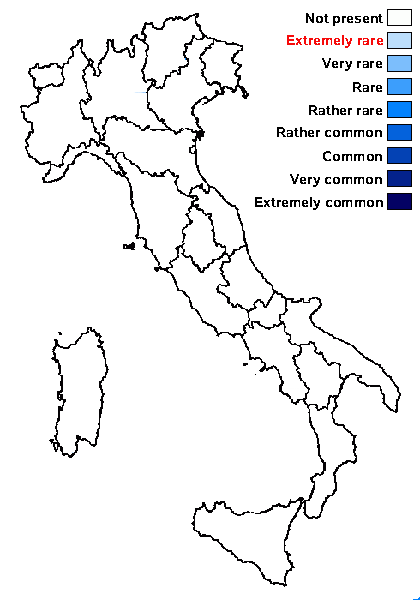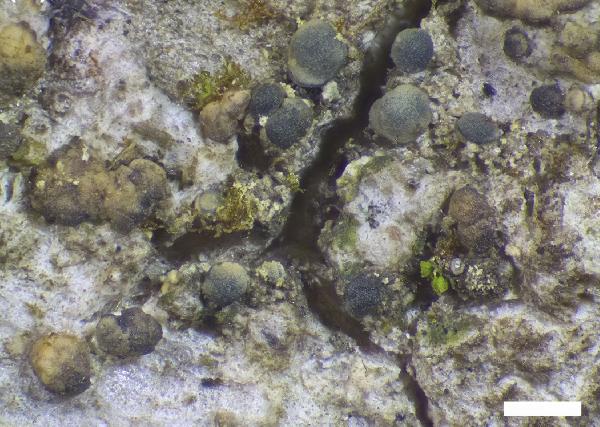Bacidina caerulea (Körb.) S. Ekman
Nordic J. Bot.: e03846, 4. 2023. Basionym: Bacidia caerulea Körb. - Parerga Lichenol., 2: 134, 1860
Synonyms:
Distribution:
Description: Thallus crustose, episubstratic, pale grey to grey-green, thin to rather thick, consisting of ca. (30-)50-85(-120) µm wide (in water), globose to ellipsoid, often slightly flattened, firmly fused granules (hence often difficult to measure), forming a warted-granular, sometimes slightly cracked crust; prothallus thin, whitish, immersed between discontinuous granules. Apothecia biatorine, 0.2-0.7 mm across, at first flat, finally more or less convex, often confluent and tuberculate, with an often piebald, pale straw and more or less blue-grey to bluish disc, and a usually darker, bluish, initially slightly raised, finally excluded margin. Proper exciple 27-61 µm wide, without crystals, more or less blue-green in upper part, sometimes also with a faint, diffuse brownish hue along the edge, the pigmentation fading inward; excipular hyphae radiating, dichotomously branched and anastomosing, in inner part thin-walled with cylindrical cell lumina, up to 1.5 µm thick and at least 30 µm long, the terminal 1-2 cells distinctly larger than the subterminal cells, more or less globose, 3-13 µm wide; epithecium blue-green; hymenium 56-68 µm high, making up 27-45% of the height of the apothecium, colourless but sometimes with blue-green vertical streaks, without crystals; paraphyses 1.1-1.6 µm thick at mid-level, unbranched or sparsely branched in uppermost part, the apical cells more or less clavate, 2-4.7 µm wide; hypothecium colourless or very pale yellowish. Asci 8-spored, clavate to cylindrical-clavate, the apical dome K/I+ dark blue with a pale, conical-pointed apical cushion (axial mass) never penetrating through the entire d-layer, the wall K/I-, but the thin outer gel K/I+ blue, Bacidia-type. Ascospores (0-)2-7-septate, hyaline, needle-like, straight to slightly curved 31-53 x 2-2.8 µm, 13-23 times as long as wide. Pycnidia rare, 30-50 µm across, immersed with an exposed ostiole, unilocular, globose, unpigmented except for a blue-green ring around the ostiole. Conidia thread-like, straight or more or less curved, non-septate, 6-14 x 0.5-0.7 µm. Photobiont chlorococcoid. Spot tests: thallus K-, C-, KC-, P-, UV-. Chemistry: thallus without lichen substances; apothecia and pycnidia with Bagliettoana-green, apothecia sometimes also with small amounts of Laurocerasi-brown. Note: on the coarse, porous bark of old Sambucus nigra, occasionally on other trees with subneutral bark, in rather shaded situations. This recently-resurrected species was long treated as a synonym of B. friesiana, from which it mainly differs in the pigmentation of the apothecia (see Ekman 2023). To be looked for in Italy.
Growth form: Crustose
Substrata: bark
Photobiont: green algae other than Trentepohlia
Reproductive strategy: mainly sexual

Predictive model
Growth form: Crustose
Substrata: bark
Photobiont: green algae other than Trentepohlia
Reproductive strategy: mainly sexual

Predictive model
 INDEX FUNGORUM
INDEX FUNGORUM
 GBIF
GBIF


